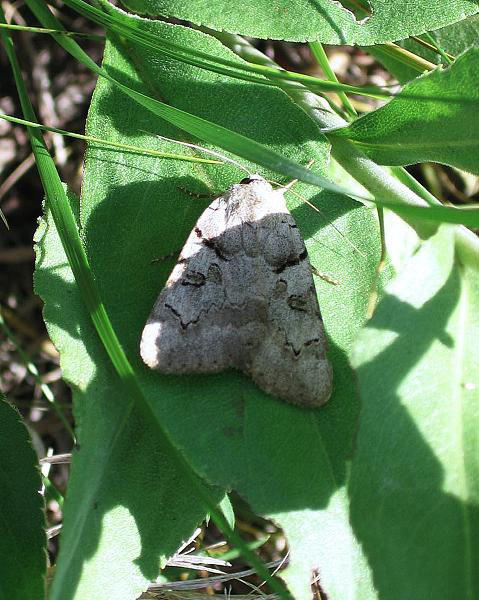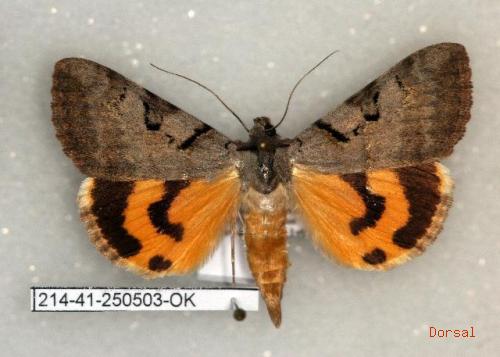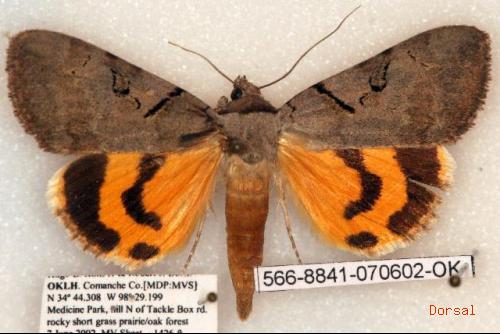Catocala abbreviatella
kah-TOCK-uh-lahM
ab-bree-vee-uh-TEL-luh
Grote, 1872


The Abbreviated Underwing, by Harold J. Vermes.
This site has been created by
Bill Oehlke.
Comments, suggestions and/or additional information are welcomed by Bill.
| TAXONOMY:
Superfamily: Noctuoidea
Family: Erebidae, Leach, [1815]
Subfamily: Erebinae, Leach, [1815]
Tribe: Catocalini, Boisduval, [1828]
Genus: Catocala, Schrank, 1802
|
DISTRIBUTION:
The Catocala abbreviatella moth (wingspan: 40-50mm) flies from Indiana south and west to
Texas and Oklahomaand north to Nebraska and
Wisconsin.
It has also been confirmed in
Arkansas,
Illinois,
Iowa,
Kansas,
Minnesota,
Missouri,
North Dakota and
South Dakota.
This species is more common in western portions of its range. In Indiana, it is considered endangered by the Natural Resources Commission (January 2005).
The forewing is uniformly colored with narrow black lines on the anterior half. The brown reniform spot is ringed with black.

Catocala abbreviatella, Oklahoma, All leps Barcode of Life.
The outer black band of the hindwing is abbreviated and then continued with a dot. The inner black band also terminates well
before the inner margin. There is considerable bleeding of orange into the fringe.

Catocala abbreviatella, Oklahoma,
All leps Barcode of Life.
Similar species: Catocala nuptialis has a solid black reniform spot. C. whitneyi has broad dark triangles in the middle of the forewing.
FLIGHT TIMES AND PREFERRED FOOD PLANTS:
In Illinois, Nebraska and Wisconsin Catocala abbreviatella are usually on the wing in
July and/or August.
Moths come in to lights readily and also to bait.
The Catocala abbreviatella caterpillar shows a preference for Lead Plant (Amorpha) and possibly Locust (Robinia).
ECLOSION:
Adults eclose from pupae formed under surface litter.
SCENTING AND MATING:
Catocala abbreviatella females
emit an airbourne pheromone and males use their antennae to track the
scent plume.
EGGS, CATERPILLARS, COCOONS AND PUPAE:
Eggs are deposited on tree bark in the fall and hatch the following spring.
Mature larvae Image courtesy of |
 |
Larval Food Plants
Listed below are primary food plant(s) and alternate food plants. It is hoped that this alphabetical listing followed by the common
name of the foodplant will prove useful. The list is not exhaustive, although some species seem very host specific.
Experimenting with closely related foodplants is worthwhile.
Return to Main Index
This page is brought to you by Bill Oehlke and the
WLSS. Pages are on space rented from Bizland. If you would like to become a "Patron of the Sphingidae/Catocala Sites",
contact Bill.
Please send sightings/images to Bill. I will do my best to respond to requests for identification help.
Enjoy one of nature's wonderments: Live Saturniidae (Giant Silkmoth) cocoons.

|

To show appreciation for this site, click on the flashing
butterfly to the left, a link
to many worldwide insect sites. |





